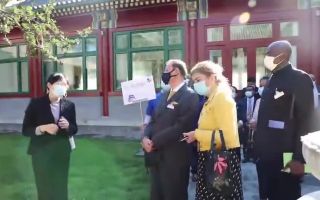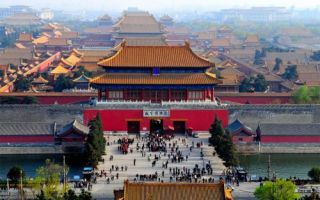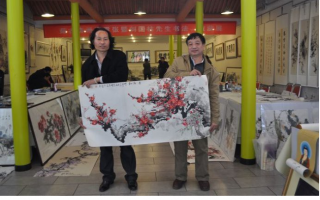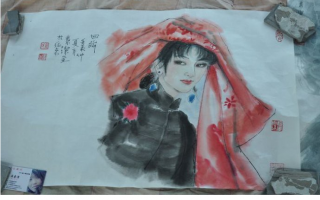《去琉璃厂》
- 2021-08-31 10:04:01
- 点赞量:6801
- 点击量:101075
- 作者:郝连成 Hao Liancheng
琉璃厂在北京可算个有名的文化去处,只是今天才有幸光顾。按说琉璃厂 坐落在和平门南边,离上次去陪王总吃全聚德烤鸭店不到300米的地方,只是因为不知道才错过了一-次机会,以致让王总在和平门边的那家宾馆闷呆了一天。其实来北京逛逛琉璃厂 也算是领略了北京的历史文化。
Liulichang is a famous cultural destination in Beijing. It is only today that we have the honor to patronize it. It is said that Liulichang is located in the south of the peace gate. It is less than 300 meters away from the last time I went to eat Quanjude roast duck restaurant with President Wang. I just missed an opportunity because I didn't know, so that President Wang stayed in the hotel next to the peace gate for a day. In fact, visiting Liulichang in Beijing is also a taste of Beijing's history and culture.
资料上说:闻名中外的京城琉璃厂文化街,位于现在北京的和平门外,西至宣武区的南北柳巷,东至宣武区的延寿寺街,全长约800米。从历史上远在辽代,这里并不是城里,而是郊区,当时叫“海王村”。后来,到了元朝这里开设了官窑,烧制琉璃瓦。自明代建设内城时,因为修建宫殿,就扩大了官窑的规模,琉璃厂成为当时朝廷工部的五大工厂之一。
According to the data, the famous Liulichang Cultural Street in Beijing is located outside Hepingmen gate in Beijing, West to the North-South Liuxiang in Xuanwu District and east to yanshousi street in Xuanwu District, with a total length of about 800 meters. Historically, as far back as the Liao Dynasty, it was not a city, but a suburb. It was called "Haiwang village" at that time. Later, in the Yuan Dynasty, an official kiln was opened here to burn glazed tiles. Since the construction of the inner city in the Ming Dynasty, because of the construction of the palace, the scale of the official kiln was expanded, and Liulichang became one of the five factories of the Work Department of the imperial court at that time.
到明嘉婧三十二年修建外城后,这里变为城区,琉璃厂便不宜于在城里烧窑,而迁至现在的门头沟区的琉璃渠村,但"琉璃厂”的名字则保留下来,流传至今。
After the construction of the outer city in the 32nd year of Jiajing of the Ming Dynasty, it became an urban area. Liulichang was not suitable for burning kilns in the city, but moved to liulichu village in Mentougou District. However, the name of "Liulichang" has been retained and has been handed down to this day.
清初顺治年间,在京城实行满汉分城居住”。而琉璃厂恰恰是在外城的西部,当时的汉族官员多数都住在附近,后来全国各地的会馆也都建在附近,官员、赶考的举子也常聚集于此逛书市,使明朝时红火的前门、灯市口和西城的城隍庙书市都逐渐转移到琉璃厂。 各地的书商也纷纷在这里设摊、建室、出售大量藏书。繁华的市井,便利的条件,形成了“京都雅游之所”,使琉璃厂逐渐发展成为京城最大的书市,形成了人文荟萃的文化街市,与文化相关的笔墨纸砚,古玩书画等等,也随之发展起来。
During the Shunzhi period in the early Qing Dynasty, Manchu and Han lived in different cities in the capital. The Liulichang factory is located in the western part of the outer city. Most of the Han officials then lived nearby. Later, the guilds in various parts of the country were built nearby. Officials and the exorcisant of the examination were also gathered in the book market, so that the front door, the lamp market and the Town God's Temple book market in the west of the Ming Dynasty were gradually transferred to Liulichang. Booksellers everywhere also set up stalls, built rooms and sold a large number of books here. The prosperous market and convenient conditions have formed a "place for elegant travel in Kyoto", making Liulichang gradually develop into the largest book market in Beijing, forming a cultural market with a large number of people, and cultural related pen, ink, paper and inkstone, antique calligraphy and painting, etc.
清末,在原琉璃厂厂址上修建了师范学堂,这就是现在的师大附中的前身。在原厂址往南修建了海王村公园,成为了琉璃厂集市的中心,也是后来厂甸最为热闹的地方之一。 1927年, 又建了和平门,修了新华街。从此,琉璃厂文化街分成了如今的东琉璃厂和西琉璃厂。
In the late Qing Dynasty, a normal school was built on the site of the original Liulichang, which is the predecessor of the middle school attached to the normal university. Haiwang Village Park was built to the south of the original plant site, which became the center of Liulichang market and one of the most lively places in Changdian later. In 1927, the peace gate and Xinhua street were built. Since then, Liulichang Cultural Street has been divided into East Liulichang and West Liulichang.
今天去这里时,主要的布局结构还是那样,以新华大街为中心分东西两部分,北师大附中在路东,从北师大往南走一-段路就看 到路两边各种‘斋”堂” 居”之类的牌扁渐多时我知道琉璃厂到了。
When I went here today, the main layout structure was the same. With Xinhua Street as the center, it was divided into East and west parts. The middle school affiliated to Beijing Normal University was in the east of the road. Walking a section of the way from Beijing Normal University to the south, I saw various "Zhai" Hall "and" Ju "signs on both sides of the road. For a long time, I knew Liulichang had arrived.

在横跨新华大街的天桥上,几块砖头压着的人物画把我吸引过去,原来作者叫温素洁,是个在校读研的女孩。
On the overpass across Xinhua Street, the figure paintings pressed by several bricks attracted me. The original author was Wen Sujie, a girl who was studying in graduate school.

张艺,笔名阿艺,号梅川、又东岳山人,艺德轩,磐石斋主。一九六四年生于曹州,一个翰墨世家。一九八六年就读于中央美术学院国画系,八十年代拜著名画家关山月、王成喜先生为师,随为入室弟子,深得真传,并潜心研究中国历代名作之长。曾求教于孙其峰、于希宁、王学仲先生等名家,形成了自己的独特风格。尤其擅长画梅兰竹菊,受到王学仲先生“不要夸颜色好,只留清气满乾坤”之赞誉。现为中国美术家协会会员、国家一家美术师、山东画院高级画师、山东滕州市书画学会副会长、国画家协会理事、王学仲艺术馆研究员。 北京市茹古斋特约画家。
Zhang Yi, pseudonym a Yi, is called Meichuan, also a native of Dongyue mountain, yidexuan, the master of Panshi Zhai. Born in Caozhou in 1964, he is a calligraphy family. He studied in the Department of traditional Chinese painting of the Central Academy of Fine Arts in 1986. In the 1980s, he took the famous painters Guan Shanyue and Wang Chengxi as his teachers, followed by his disciples, won the true legend, and devoted himself to the study of the strengths of Chinese Masterpieces of previous dynasties. He once sought advice from famous masters such as sun Qifeng, Yu Xining and Mr. Wang Xuezhong, and formed his own unique style. He is especially good at painting plum, orchid, bamboo and chrysanthemum, and is praised by Mr. Wang Xuezhong for "don't boast about the good color, just leave the clear air to fill the universe". Now he is a member of China Artists Association, a national artist, a senior painter of Shandong Academy of painting, vice president of Shandong Tengzhou calligraphy and painting society, director of National Artists Association and researcher of Wang Xuezhong Art Museum. Beijing ruguzhai special painter.

2011年作品《铁骨生香》入选庆祝共产党90周年曹县书画大展作品集。
In 2011, the work "iron bone makes fragrance" was selected into the collection of works of Cao county calligraphy and painting exhibition celebrating the 90th anniversary of the Communist Party.
2011年作品《幽香透国魂》入选全国名家书画展精品集。
In 2011, the work "fragrance through the soul of the country" was selected into the boutique collection of national famous calligraphy and painting exhibition.
2010年作品《梅开五福》入选水墨敦煌’当代中国画名家邀请展。
In 2010, the work plum blossom and five blessings was selected into the invitation exhibition of contemporary Chinese painters in Dunhuang.
2009年作品《雪梅迎春》获枣庄市美协举办的第二届会员展。
In 2009, the work "snow plum greeting spring" won the second member exhibition held by Zaozhuang Art Association.
2007年作品《红梅赞》入选首届《悲鸿奖》全国书画大展优秀作品奖。
In 2007, the work "red plum praise" was selected as the excellent work award of the first national calligraphy and painting exhibition of "Beihong Award".
2004年作品《冷艳吐香》赴北京工人文化宫展出并载版于《墨子故里书画篆刻作吕集》
In 2004, the work Leng Yan Tu Xiang was exhibited at the workers' Culture Palace in Beijing and published in Lu Ji, calligraphy, painting and seal cutting in Mozi's hometown
2003年作品《春满乾坤》获中国美协主办全国中国画作品展优秀奖。
In 2003, his work "spring is full of heaven and earth" won the excellence award of the national Chinese Painting Exhibition hosted by the China Artists Association.
2002年人民大会堂国画办公厅之邀,参加全国书画名家做谈会。作品及事迹近年来 《中国书画报》《山东商报》 《美术报》《国画家》 等报刊发表介绍。出版有《梅花画集》;《张艺中国画集》《张艺水墨艺术》 《张艺画集》。
In 2002, at the invitation of the general office of traditional Chinese painting in the Great Hall of the people, he participated in the seminar of national famous calligraphers and painters. Works and deeds in recent years Books and paintings, Shandong business daily, art daily, Chinese painter and other newspapers and periodicals published introductions. Published plum blossom paintings《 Zhang Yi China Paintings, Zhang Yi's ink art, Zhang Yi's paintings.
郝连成写于北京通州
Written by Hao Liancheng in Tongzhou, Beijing
2013-04-21
2013-04-21







0 条 评 论 Write a Response